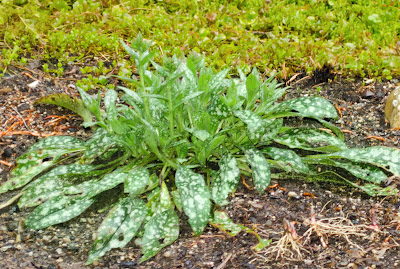When I was a kid, I used to sit for hours on the beach, sifting sand, looking for miniature shells. Tiny mussels, snails, Baltic macomas in pink and yellow, dime-sized sand dollars, little stripy clams, limpets with chimney holes: I loved them all, and always went home with a pocketful.
I don't sit on the beach any more, but I still keep an eye out for the delicate mini-shells. Pretty clams turn up on the White Rock beach, macomas at Iona Beach, periwinkles on Crescent Beach. At Boundary Bay, besides the ever-present mud snails and big broken clams, the remainders of gull dinners, I don't see many others. Occasionally, I find a few pink macomas or a sharply-pointed snail shell. And rarely, maybe three times in all the years I've been looking, I find a bubble shell.
 |
| Probably Haminoea vesicula. Very thin, extremely fragile, translucent, and so light I could blow it away. This one is 7 mm long. |
 |
| Underside. Or rather, inside bottom. |
In spring and summer, they say the animal itself can be found in beds of sea lettuce and eelgrass. I had never seen it. And the rest of the year, it may as well be invisible; it blends in perfectly with the sand.
I found an oval bubble shell (the animal, not the shell) in a bag of eelgrass and sea lettuce that I brought home for my hermits. When I washed the veggies, a tiny slug-like thing oozed out and across the bottom of my bowl.
 |
| Haminoea japonica, top view. About 3/4 inch long, stretched out. |
This is a mollusc, related to the
aglaja that I found last year. Here's a mouthful:
it's "a marine opisthobranch gastropod mollusc in the family Haminoeidae" (Wikipedia)
Opisthobranch means "gills behind" (and to the right of the heart). ... Opisthobranchs are characterized by two pairs of tentacles and a single gill behind and to the right of the heart. (Wikipedia, again)
I didn't see the tentacles, unless they are those two little protrusions on the sides of the head. It's hard to tell, because of the unusual head: the oval bubble shell is distinguished by hir forked head shield, like a flat helmet. And the front of the foot is flattened out underneath this shield, making it look from the side as if the animal had fat lips.
 |
| "Mouth" closed. |
 |
| "Mouth" open. I think those two black dots are eyes. |
Unlike the sea slugs, Hammy has a shell. But the flesh of the foot folds up around the outside of the shell, in two wings over the sides, and a smaller cover at the tail end. I took these photos as s/he slid across a piece of sand dollar; on the sand, the spotted body blends in so perfectly that only the top of the shell can be seen. Once it reaches the sand, s/he buries hirself quickly, in a few seconds.
 |
| Fully stretched out, crawling up the glass wall of the aquarium. The underside. The shell is visible, but encased in flesh. Head at the top, tail end floating free. A minute later, s/he let go, floated to the sand, and disappeared. |
This bubble shell eats vegetation, like the sea lettuce and sea hair algae, as well as diatoms. (The aglaja, hir cousin, is a carnivore, and eats bubble shells.) S/he also eats sand, which can be found in hir gizzard. (And I thought only birds had gizzards!)
As s/he travels along, s/he leaves a trail of slime, which possibly may serve to guide other bubble shells to hir location. I noticed this when s/he climbed up the glass wall; behind hir, a string of tiny bubbles caught the light.
This whole sub-class, the Opisthobranchia, boasts some of the strangest animals in the ocean. It includes the nudibranchs, with their amazing colours and imaginative body shapes, the "flying" sea angel, the winged slug, the stomach wing, the sacoglossa sapsuckers, that look more like scraps of rag than animals. (
This page has some of our local specimens Or see
National Geographic's photos of nudis. Unbelievable!.)
"Hammy" at least looks sensible, but s/he has hidden talents. The bubble shells are hermaphroditic; each one is both male and female. After mating, s/he lays the eggs in small, yellow, sausage-shaped clumps, from 300 to 700 yoked eggs in each.
So far, this is unsurprising. But then, the some of the eggs hatch into tiny swimming veligers, free-living. These go through several stages, out on their own in the water, not eating, but risking being eaten, before they mature and settle down to a slug shape.
 |
| Veliger of a sea hare, a relative of Haminoea. 50 nanometres. Wikipedia. |
Other eggs wait to hatch until they are mature, crawling little bubble shells. (
CIESM Atlas) There are advantages to both strategies; the veligers get to populate new territory, while the homebodies are safer.
Haminoea vesicula (the empty shell above) is a native: H. japonica is an import from Japan, previously known there as H. callidegenita. It has now spread worldwide. It doesn't seem to be invasive, but may be carrying the organism that causes
swimmer's itch.
Carry a towel!




















































